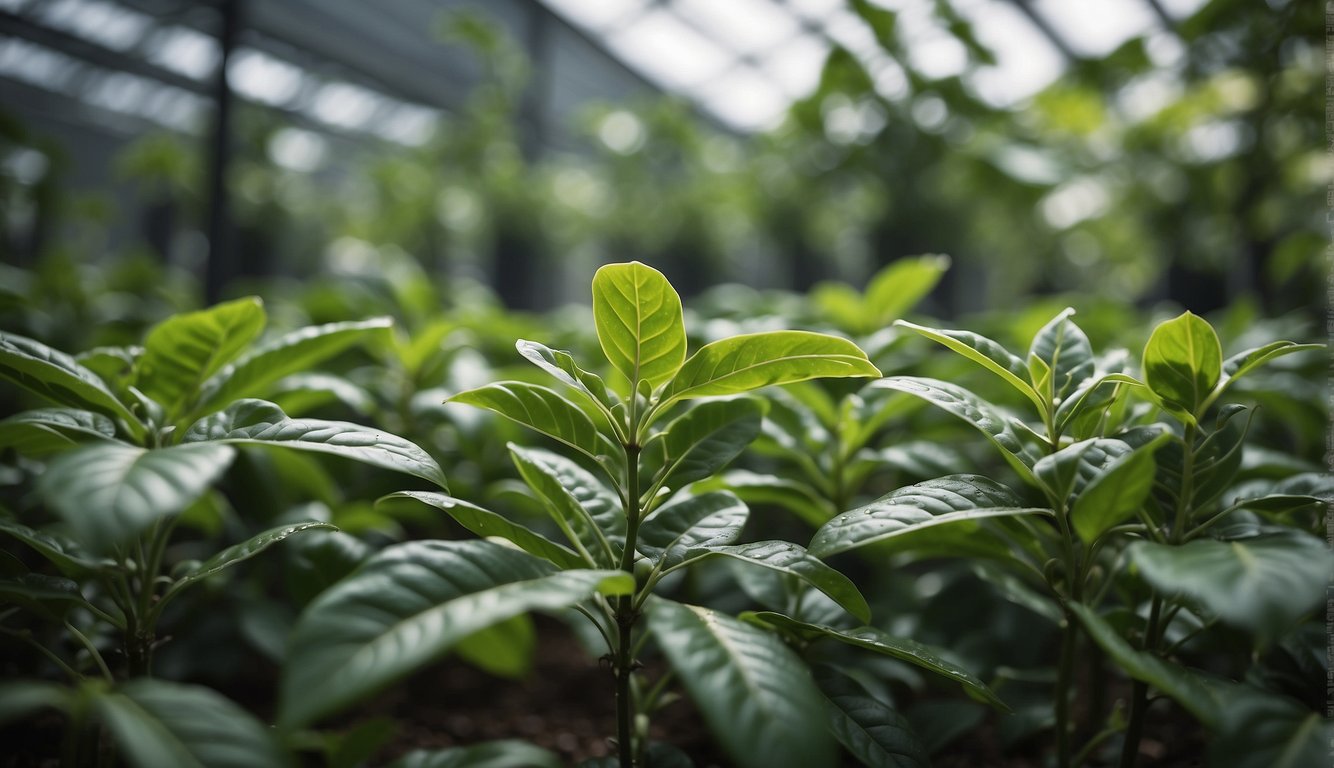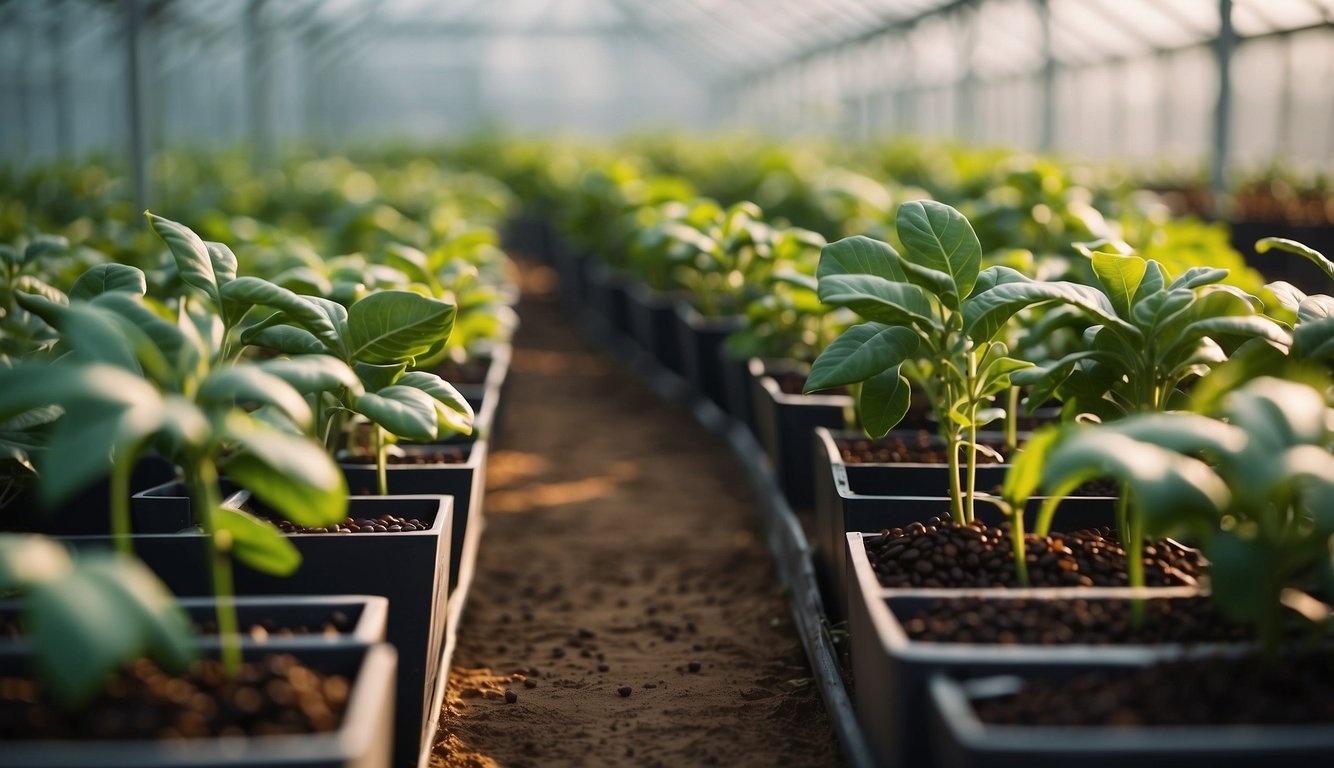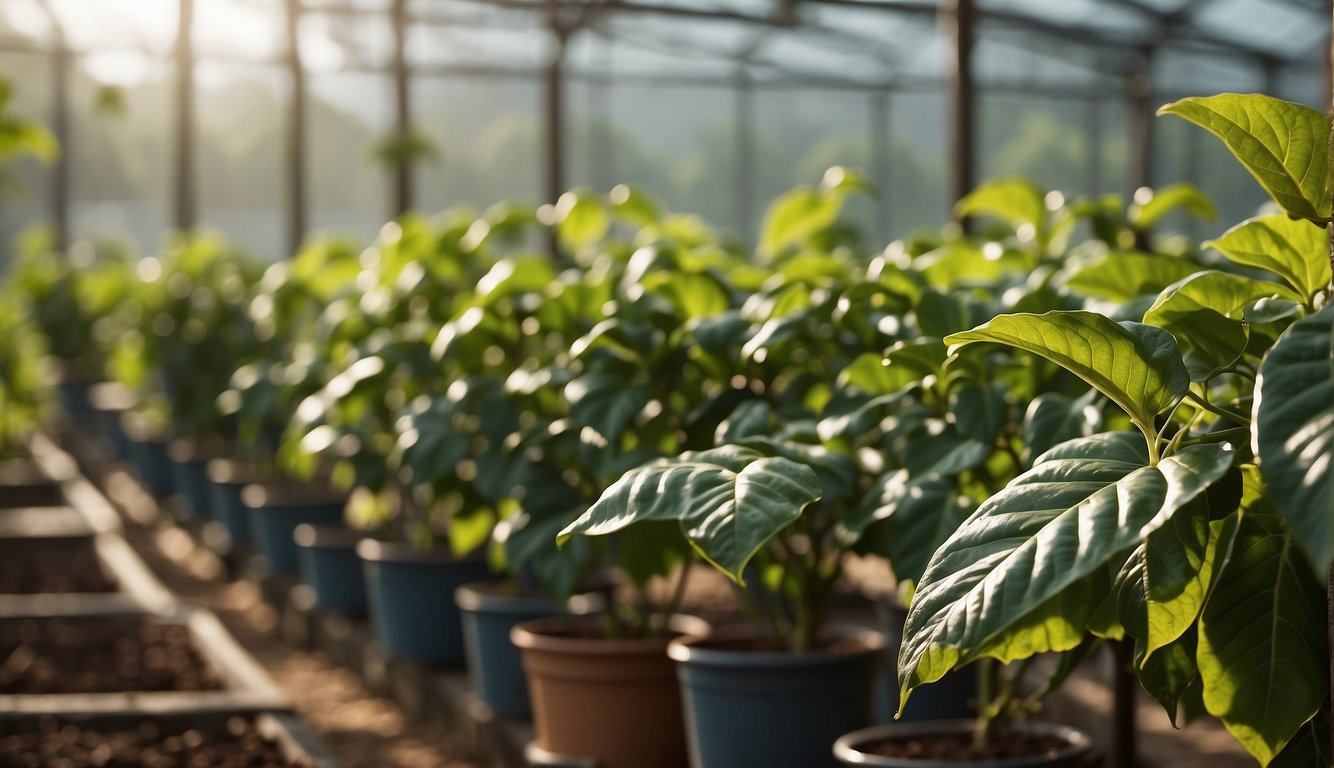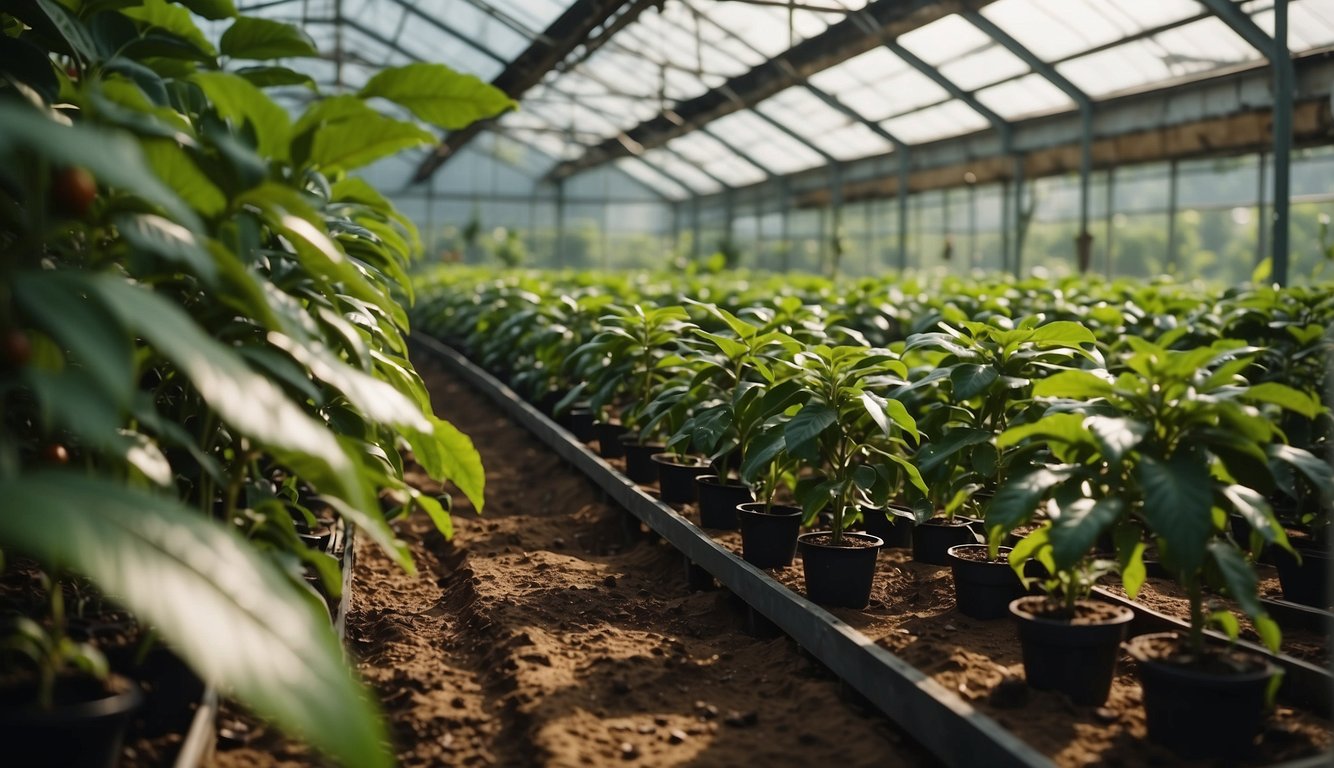TheHerbProf.com is a treasure trove of knowledge for those interested in natural healing and herbal remedies. The website is run by Paul Johnston MD. A naturopathic who has not only received extensive education in the field but also has personal experience in self-healing.
Grow coffee in greenhouse is a unique and exciting way to cultivate coffee plants. It allows coffee growers to have more control over the growing environment and produce high-quality coffee beans year-round. Greenhouse coffee cultivation can be a profitable venture for those who are willing to put in the time and effort required.
To successfully grow coffee in a greenhouse, it is essential to choose the right type of coffee plant. Arabica and Robusta are the two most popular species of coffee plants, and Arabica is the preferred choice for greenhouse cultivation. Arabica plants thrive in higher altitudes and cooler temperatures, making them ideal for greenhouse growing conditions. It is also important to maintain strict environmental conditions, including temperatures between 60 and 70 degrees F with high humidity. Mist and cloud-like conditions are helpful to keep the plants healthy and productive.
Greenhouse coffee cultivation requires a significant investment in both time and money. The cost of a coffee greenhouse can range from $2,000 to $5,000, depending on the size and type of orangery chosen. Additionally, construction costs for a typical home-sized greenhouse can range from $5,000 to $10,000. However, the per square foot cost of a typical glass orangery can run as high as $25 to $35. With the right equipment, knowledge, and patience, growing coffee in greenhouse can be a rewarding and profitable venture.
Understanding Coffee Plant Basics – Get Coffee 2.0 Here!

As someone interested in growing coffee in a greenhouse, it’s important to understand the basics of coffee plants. In this section, I’ll cover two key topics: Arabica vs. Robusta and the anatomy of the coffee plant.
Arabica vs. Robusta – Get Coffee 2.0 Here!
There are two main types of coffee plants: Arabica and Robusta. Arabica is the most popular type of coffee and is generally considered to be higher quality than Robusta. Robusta coffee plants can grow at lower altitudes and in warmer climates, while Arabica coffee plants require higher altitudes and cooler temperatures to grow.
Arabica coffee plants are known for their delicate flavor profile, which can include notes of chocolate, fruit, and nuts. Robusta coffee plants, on the other hand, have a stronger and more bitter taste. However, Robusta coffee plants are also more disease-resistant and easier to grow.
Anatomy of the Coffee Plant – Grow Coffee in Greenhouse
Coffee plants are small trees that can grow up to 30 feet tall. They have dark green leaves and produce small, white flowers that have a sweet fragrance. After the flowers bloom, they are replaced by green berries that eventually turn red as they ripen.
Inside the coffee berry are two seeds, which are commonly referred to as coffee beans. These beans are what are harvested and used to make coffee. The beans are surrounded by a thin layer of pulp, which is removed during processing.
Understanding the basics of coffee plants is essential for anyone interested in growing coffee in a greenhouse. By knowing the differences between Arabica and Robusta and the anatomy of the coffee plant, you can make informed decisions about which type of coffee plant to grow and how to care for it.
Setting Up Your Greenhouse – Grow Coffee in Greenhouse
As someone who has been growing coffee in a greenhouse for years, I can attest to the benefits of this method. However, it’s important to make sure you set up your greenhouse correctly to ensure optimal growth and yield. Here are a few things to keep in mind when setting up your coffee greenhouse:
Choosing the Right Greenhouse – Get Coffee 2.0 Here!
The first step in setting up your coffee greenhouse is choosing the right one. When selecting a greenhouse, consider the size, material, and shape. Glass greenhouses are the most common, but you can also use plastic or polycarbonate. The shape of the greenhouse is also important. A taller greenhouse will allow for more air circulation, while a wider one will provide more space for your coffee plants.
Another factor to consider is the location of your greenhouse. Choose a spot that gets plenty of sunlight but is also protected from strong winds. You may also want to consider using shade cloth to protect your coffee plants from too much direct sunlight during the hottest parts of the day.
Greenhouse Environment Control – Grow Coffee in Greenhouse
Once you have your greenhouse set up, it’s important to control the environment inside. Coffee plants thrive in a warm and humid environment, so you’ll need to maintain a temperature of around 60-70°F and humidity of around 60-70%. You can use a humidifier to help regulate the humidity levels.
In addition to temperature and humidity, you’ll also need to control the amount of light your coffee plants receive. Coffee plants need around 12 hours of sunlight per day, so you may need to supplement with artificial light during the winter months.
Overall, setting up a coffee greenhouse requires attention to detail and careful planning. But with the right setup, you can enjoy fresh, homegrown coffee year-round.
Coffee Plant Cultivation – Grow Coffee in Greenhouse

Soil Preparation – Get Coffee 2.0 Here!
The first step in growing coffee plants in a greenhouse is to prepare the soil. I prefer to use a soil mix that is rich in compost and worm castings. This type of soil mix provides the necessary nutrients and helps to retain moisture. I recommend using a soil pH test kit to ensure that the soil pH is between 6.0 and 6.5, which is the ideal range for growing coffee plants.
Planting Seeds – Grow Coffee in Greenhouse
Once the soil is prepared, it is time to plant the coffee seeds. I recommend using high-quality coffee seeds that are fresh and have been stored properly. The seeds should be planted about 1 inch deep in the soil mix and spaced about 6 inches apart. After planting, water the soil lightly to help the seeds settle in.
Germination Process
The germination process for coffee seeds can take anywhere from 2 to 6 weeks. During this time, it is important to keep the soil moist but not waterlogged. I recommend covering the soil with a clear plastic cover to help retain moisture and create a humid environment. Once the seeds have germinated, remove the cover and provide the coffee plants with plenty of light.
In summary, growing coffee plants in a greenhouse is a rewarding and enjoyable experience. By following these simple steps for soil preparation, planting seeds, and the germination process, you can successfully grow coffee plants in your greenhouse. Remember to use high-quality seeds, a nutrient-rich soil mix, and keep the soil moist but not waterlogged. With a little patience and care, you can enjoy a bountiful harvest of delicious coffee beans.
Optimal Growing Conditions – Grow Coffee in Greenhouse

As a coffee grower, I understand the importance of providing optimal growing conditions for your coffee plants. In a greenhouse, you have more control over the environment, which can help you create the perfect conditions for your coffee plants to thrive. Here are some of the optimal growing conditions for coffee plants in a greenhouse.
Temperature and Humidity Levels
Coffee plants thrive in warm, humid environments. The ideal temperature range for coffee plants is between 60 and 70 degrees Fahrenheit, with humidity levels between 60 and 70 percent. To maintain these optimal conditions, you may need to install a misting system to keep the air moist, especially during the dry months.
Light and Shade Management
Coffee plants require a lot of sunlight, but too much direct sunlight can damage the leaves. To manage the light and shade in your greenhouse, you can install shade cloth or use a trellis system to provide partial shade for your plants. This will help protect the leaves from direct sunlight while still allowing them to get the light they need to grow.
Watering and Moisture – Get Coffee 2.0 Here!
Water is essential for coffee plants, but too much water can cause root rot. To avoid overwatering your plants, you can use rainwater or warm water to water your plants. This will help maintain the optimal moisture levels in the soil without drowning the roots.
In summary, maintaining optimal growing conditions for your coffee plants in a greenhouse requires careful attention to temperature, humidity, light, and water. By providing the right conditions, you can help your coffee plants thrive and produce high-quality beans.
Nutrition and Plant Health – Grow Coffee in Greenhouse – Get Coffee 2.0 Here!

As with any plant, providing your coffee plants with the right nutrients is essential for their growth and health. In a greenhouse environment, it’s important to pay close attention to fertilization and pest and disease management.
Fertilizing Your Coffee Plants – Grow Coffee in Greenhouse
Coffee plants require a balanced blend of nutrients, including nitrogen, phosphorus, and potassium. One effective fertilizer for coffee plants is fish emulsion, which is high in nitrogen and also provides trace minerals. It’s important to avoid over-fertilizing, as this can lead to excessive vegetative growth at the expense of fruit production.
To ensure your coffee plants are getting the right nutrients, consider conducting a soil test to determine any deficiencies. This will help you choose the right fertilizer and application rate for your plants.
Pest and Disease Management
Greenhouses can provide a controlled environment that reduces the risk of pest and disease infestations. However, it’s still important to monitor your plants regularly and take action at the first sign of trouble.
Common pests that can affect coffee plants include spider mites, mealybugs, and scale insects. One effective way to manage these pests is to introduce natural predators such as ladybugs or lacewings.
Diseases such as coffee rust and leaf spot can also affect coffee plants. To prevent these diseases, ensure good air circulation and avoid over-watering. If a disease is detected, remove and destroy affected plant parts and treat with a fungicide if necessary.
By providing your coffee plants with the right nutrients and managing pests and diseases effectively, you can ensure healthy growth and a bountiful harvest.
Coffee Plant Maintenance – Grow Coffee in Greenhouse

As with any plant, coffee plants require regular maintenance to ensure their health and productivity. In this section, I will discuss two important aspects of coffee plant maintenance: pruning and size control, and monitoring growth and health.
Size Control and Pruning
Pruning is an essential part of coffee plant maintenance, as it helps to control the size and shape of the plant and promotes healthy growth. Pruning should be done regularly, ideally once or twice a year, and should focus on removing dead or diseased branches, as well as any branches that are growing in the wrong direction or interfering with other branches.
To prune a coffee plant, I recommend using sharp, clean pruning shears and making cuts at a 45-degree angle just above a node. It’s important to avoid cutting too much at once, as this can stress the plant and reduce its productivity. Instead, I suggest pruning a little bit at a time, and monitoring the plant’s response to ensure that it remains healthy.
In addition to pruning, size control is also an important part of coffee plant maintenance. This can be achieved through a variety of methods, such as using trellises or stakes to support the plant, or using specialized pruning techniques to encourage growth in specific areas.
Monitoring Growth and Health – Grow Coffee in Greenhouse
Another important aspect of coffee plant maintenance is monitoring the plant’s growth and health. This involves keeping an eye on the plant’s overall appearance, as well as monitoring factors such as soil moisture, temperature, and airflow.
To monitor the plant’s health, I recommend conducting regular inspections of the leaves, stems, and roots, looking for signs of disease or pest infestation. If any issues are detected, it’s important to take action quickly to prevent the problem from spreading.
In addition to visual inspections, I also recommend using tools such as moisture meters and temperature gauges to monitor the plant’s environment. This can help to ensure that the plant is receiving the right amount of water and nutrients, and that the temperature and humidity levels are optimal for growth.
Overall, regular maintenance is essential for ensuring the health and productivity of coffee plants. By following these tips for pruning and size control, and monitoring growth and health, I am confident that anyone can grow healthy, productive coffee plants in their greenhouse.
Harvesting and Processing – Grow Coffee in Greenhouse

As a coffee grower, I know that harvesting and processing are crucial steps in producing high-quality beans. Here, I will discuss the steps involved in harvesting and processing coffee beans in a greenhouse.
Identifying Ripe Coffee Beans
The first step in harvesting coffee beans is identifying when they are ripe. Coffee beans grow inside small, red berries that turn bright red when they are ready to be harvested. It is important to wait until the berries are fully ripe to ensure the best taste and quality of the beans.
Harvesting Techniques – Grow Coffee in Greenhouse
Once the berries are ripe, it is time to harvest them. There are two main harvesting techniques: hand-picking and strip-picking. Hand-picking involves picking the berries one by one, which is time-consuming but ensures that only the ripest berries are harvested. Strip-picking involves stripping all the berries off the branch at once, which is faster but can result in unripe or overripe berries being harvested.
Drying and Roasting – Get Coffee 2.0 Here!
After the berries are harvested, they need to be dried and roasted. Drying can be done in several ways, including sun-drying, machine-drying, or a combination of both. Once the beans are dry, they are roasted to bring out their unique flavors and aromas.
Harvesting and processing are essential steps in producing high-quality coffee beans. By identifying ripe berries, using the right harvesting techniques, and properly drying and roasting the beans, coffee growers can produce beans with unique and delicious flavors.
Maximizing Coffee Yields – Grow Coffee in Greenhouse

Growing coffee in greenhouse can be a great way to maximize yields. By controlling the environment, you can extend the growing season and scale up production. In this section, I will discuss two ways to maximize coffee yields: extended growing seasons and scaling up production.
Extended Growing Seasons – Grow Coffee in Greenhouse
One of the biggest advantages of growing coffee in a greenhouse is the ability to extend the growing season. With a greenhouse, you can control the temperature, humidity, and light, which can help you grow coffee year-round. This can lead to higher yields and a more consistent supply of coffee.
To extend the growing season, it is important to maintain the right temperature and humidity levels. Coffee plants grow best in temperatures between 60°F and 70°F, and humidity levels between 50% and 60%. By using a heater or air conditioner, you can maintain the right temperature, and by using a humidifier or dehumidifier, you can maintain the right humidity levels.
Scaling Up Production – Get Coffee 2.0 Here!
Another way to maximize coffee yields is to scale up production. With a greenhouse, you can grow more coffee plants in a smaller space, which can help you increase production without having to expand your farm. This can also help you save on labor costs, as you can automate many of the tasks involved in growing coffee.
To scale up production, it is important to choose the right coffee varieties and to use the right cultivation techniques. Arabica and Robusta are the two major types of coffee plants suitable for greenhouse cultivation, with each having unique characteristics and requirements. Additionally, using hydroponics can help you grow more coffee plants in a smaller space, as it allows you to grow plants without soil.
By extending the growing season and scaling up production, you can maximize coffee yields when growing coffee in greenhouse. By controlling the environment and using the right cultivation techniques, you can grow more coffee plants in a smaller space, which can lead to higher yields and a more consistent supply of coffee.
Before You Go – Grow Coffee in Greenhouse

Growing coffee in a greenhouse can be a challenging but rewarding endeavor. With the right knowledge, tools, and care, you can enjoy freshly roasted coffee beans year-round from the comfort of your own home.
Throughout this article, we have discussed the benefits of growing coffee in a greenhouse, including increased control over environmental conditions, extended growing seasons, and protection from pests and diseases. We have also explored the different types of coffee plants suitable for greenhouse cultivation, such as Arabica and Robusta, and the steps involved in planting coffee from seeds.
It is important to note that growing coffee in greenhouse requires a significant investment of time, effort, and resources. You will need to monitor and adjust the temperature, humidity, and lighting to ensure optimal growing conditions. You will also need to provide regular care and maintenance, such as watering, fertilizing, and pruning.
To ensure the success of your coffee plants, it is recommended to consult with experienced growers, join online communities, and attend workshops and seminars. These resources can provide valuable insights, tips, and best practices for growing coffee in a greenhouse.
Overall, growing coffee in greenhouse can be a fulfilling and enjoyable hobby for coffee enthusiasts and hobbyists alike. With patience, dedication, and a love for coffee, you can create your own little coffee oasis in your backyard or home.
The Perfect Blend: Growing Coffee in a Greenhouse and The Herb Prof
Let’s brew up some knowledge about growing coffee in a greenhouse and its connection to our herbal paradise, theherbprof.com. Ready? Let’s spill the beans!
Firstly, growing coffee in a greenhouse is an exercise in patience and precision. It’s about creating the perfect conditions for the coffee plant to thrive. Sounds familiar? That’s because theherbprof.com does the same for your herbal wisdom!
Secondly, both coffee cultivation and theherbprof.com are about sustainability. Just like a greenhouse provides a sustainable environment for coffee, theherbprof.com promotes sustainable practices in the world of herbs.
Lastly, they both aim to enrich our lives. Coffee brings joy to our mornings, while theherbprof.com enlightens us about the wonders of herbs.
So, there you have it! Growing coffee in a greenhouse and theherbprof.com are a match made in plant heaven. They both symbolize growth, sustainability, and enrichment. Now, isn’t that a brew-tiful piece of information to share at your next garden party? Keep growing, folks!
References – Grow Coffee in Greenhouse
Little Herb Encyclopedia, by Jack Ritchason; N.D., Woodland Publishing Incorporated, 1995
The Ultimate Healing System, Course Manual, Copyright 1985, Don Lepore
Planetary Herbology, Michael Tierra, C.A., N.D., Lotus Press, 1988
Handbook of Medicinal Herbs, by James A. Duke, Pub. CRP Second Edition 2007
The Complete Medicinal Herbal, by Penelope Ody, Published by Dorling Kindersley
Check the Following Articles!
How to Propagate Thanksgiving Cactus: The Step-by-Step
Best Prepper Garden: How to Be Self-Sufficient
Propagating Succulents in Water: A Comprehensive Guide
Frequently Asked Questions – Grow Coffee in Greenhouse

What is the optimal climate for growing coffee in a greenhouse?
The optimal climate for growing coffee in a greenhouse is a temperature range of 60 to 70°F and a humidity range of 60 to 70%. Coffee plants require a lot of light, but direct sunlight can damage the plants. Therefore, it is important to provide shade and ensure proper ventilation to prevent overheating.
Are there specific varieties of coffee plants best suited for greenhouse cultivation?
Arabica and Robusta are the two major types of coffee plants suitable for greenhouse cultivation. Arabica coffee plants are more delicate and require a more stable environment, while Robusta coffee plants are hardier and can tolerate a wider range of conditions. It’s important to research the specific requirements of the coffee plant variety you choose to ensure optimal growth.
How does hydroponic cultivation compare to traditional soil methods for growing coffee?
Hydroponic cultivation can be more efficient than traditional soil methods for growing coffee in a greenhouse. Hydroponic systems allow for precise control over nutrient and water delivery, resulting in faster growth and higher yields. However, hydroponic systems can be more expensive to set up and require more maintenance than traditional soil methods.
Can indoor coffee plants in a greenhouse environment actually produce beans?
Yes, indoor coffee plants in a greenhouse environment can produce beans. However, it can take several years for the plants to mature and produce a significant yield. It is important to provide the plants with the proper care and environment to ensure optimal growth and bean production.
What are the legal considerations for cultivating coffee plants in a greenhouse?
The legal considerations for cultivating coffee plants in a greenhouse vary depending on the location. It is important to research local laws and regulations regarding the cultivation of coffee plants and obtain any necessary permits or licenses. Additionally, it’s important to ensure that the coffee plants are sourced from reputable suppliers and not illegally obtained.
How do the requirements for growing coffee differ from those for growing cocoa in a greenhouse?
The requirements for growing coffee and cocoa in a greenhouse are similar in terms of temperature, humidity, and light. However, cocoa plants require more shade than coffee plants and can tolerate slightly lower temperatures. Additionally, cocoa plants require a different nutrient mix and pH level than coffee plants. It’s important to research the specific requirements of each plant to ensure optimal growth in a greenhouse environment.


